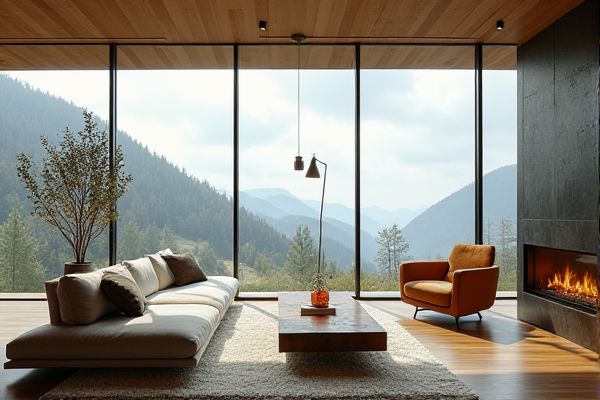
Glass windbreaks offer superior clarity and durability with a sleek, modern appearance, while acrylic windbreaks provide lightweight flexibility and easier installation at a lower cost. Discover which option best suits Your needs by reading the full comparison in this article.
Table of Comparison
| Feature | Glass Windbreak | Acrylic Windbreak |
|---|---|---|
| Material | Tempered or laminated glass | High-quality acrylic (PMMA) |
| Durability | Highly durable, scratch-resistant | Moderately durable, prone to scratches |
| Transparency | Crystal clear, no yellowing | Clear but may yellow over time |
| Weight | Heavy, requires sturdy framing | Lightweight, easy installation |
| Weather Resistance | Excellent resistance to UV, rain, and wind | Good UV resistance, less impact against harsh weather |
| Safety | Shatters into small, less harmful pieces | Breaks with larger cracks, less safe |
| Cost | Higher upfront cost | More affordable option |
| Maintenance | Low maintenance, easy to clean | Requires frequent cleaning, prone to scratches |
Introduction to Windbreak Solutions
Glass windbreaks offer superior clarity, durability, and a sleek aesthetic ideal for modern outdoor spaces, providing effective protection against wind and weather elements. Acrylic windbreaks provide a lightweight, cost-effective alternative with good impact resistance and flexibility, but they may scratch more easily and yellow over time due to UV exposure. Choosing between glass and acrylic windbreak solutions depends on factors like budget, maintenance preferences, and desired visual appeal for the outdoor environment.
Glass Windbreaks: Features and Benefits
Glass windbreaks offer superior durability and clarity, providing exceptional protection from wind without compromising visibility. Their robust, scratch-resistant surface ensures long-lasting performance and maintains aesthetic appeal in outdoor spaces. Your outdoor area benefits from the sleek, modern look and easy maintenance that glass windbreaks uniquely deliver.
Acrylic Windbreaks: Features and Benefits
Acrylic windbreaks offer superior impact resistance and lightweight durability compared to glass, making them ideal for outdoor use where safety and portability are essential. Their clarity and UV resistance preserve visibility and prevent yellowing, ensuring your windbreak remains effective and visually appealing over time. Easy installation and cost-effectiveness make acrylic windbreaks a practical choice for enhancing comfort in windy environments.
Aesthetic Appeal: Glass vs Acrylic
Glass windbreaks provide a sleek, high-end aesthetic with crystal-clear transparency and a smooth, reflective surface that enhances modern architectural designs. Acrylic windbreaks offer versatile design options with vibrant colors and textures, though they may yellow or scratch over time, slightly diminishing visual clarity. The premium, durable finish of glass maintains long-lasting elegance, while acrylic prioritizes customizable styles and lightweight practicality.
Durability and Weather Resistance
Glass windbreaks offer superior durability and excellent weather resistance, maintaining clarity and structural integrity under harsh conditions such as heavy winds, UV exposure, and temperature fluctuations. Acrylic windbreaks, while lightweight and impact-resistant, are more prone to scratching, yellowing, and becoming brittle over time due to prolonged UV exposure and weathering. The inherent toughness and non-porous surface of glass provide long-term protection and minimal maintenance compared to acrylic, making it ideal for enduring outdoor environments.
Safety and Impact Resistance
Glass windbreaks offer superior rigidity but are prone to shattering upon high impact, posing significant safety hazards. Acrylic windbreaks provide enhanced impact resistance due to their flexible, shatterproof composition, making them safer in environments prone to sudden impacts. In terms of safety, acrylic windbreaks are more reliable for preventing injury while maintaining effective wind protection.
Maintenance and Cleaning Requirements
Glass windbreaks require less frequent cleaning due to their smooth, non-porous surface, which resists stains and weathering over time. Acrylic windbreaks, while lighter and more impact-resistant, can scratch easily and may need specialized cleaners to maintain clarity and prevent dullness. Choosing glass ensures your windbreak maintains a pristine appearance with minimal maintenance effort.
Cost Comparison: Glass vs Acrylic
Glass windbreaks generally have a higher upfront cost due to the material's weight and manufacturing process, making installation more expensive compared to acrylic. Acrylic windbreaks offer a budget-friendly alternative with lower material and installation costs while still providing good durability and clarity. Your choice depends on balancing initial expenses with long-term performance and maintenance requirements.
Installation Considerations
Glass windbreak installation requires sturdy, corrosion-resistant framing, such as stainless steel or aluminum, to support the weight and maintain durability in outdoor conditions. Acrylic windbreaks are lighter and more flexible, allowing for easier mounting on various structures with simpler hardware, reducing overall installation time and labor costs. Both materials demand precise measurements and secure anchoring to withstand wind pressure and ensure long-term stability.
Choosing the Right Windbreak for Your Needs
Glass windbreaks offer superior durability and clarity, making them ideal for areas requiring strong protection and an unobstructed view. Acrylic windbreaks are lighter, more affordable, and easier to install, suitable for You if portability and budget are priorities. Assess your environment, budget, and desired aesthetics to choose the windbreak that best aligns with Your specific needs.
 homyna.com
homyna.com